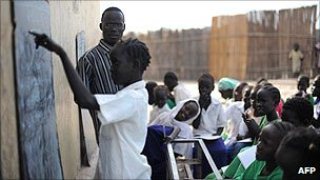S. Sudan education ministry records increase in school enrolments
January 5, 2012 (JUBA) – The annual internal report by South Sudan’s ministry of general education and instruction released on Thursday indicated an increase in enrolment at all educational levels since its establishment as educational institution in 2005.

“There was an average annual growth of less than 0.5% between 2006 and 2007 and the enrolment at the lower basic school increased from 142,623 in 2008-2009 to 128,368 in 2010-2011, registering an average annual growth rate of 2% while the basic increased from 41,493 to 75,613 during the same period with an annual average growth rate of 3%”, reads part of the report.
Apart from engaging participants to look at the three main thematic areas; access and equity, quality of teaching and learning and sector management with a view to consulting with stakeholders from whose comments will help to enrich the revised edition of the policy, the ministry highlighted an increase in enrolment at senior secondary schools, explaining that enrolment at that level doubled from 12,554 to 46,141 with an average annual growth rate of three percent between 2010 and 2011.
The report further highlighted that the gross enrolment ratio increased considerably at the ECD level from 26 percent in 2006 to 36 percent in 2009, allegedly due to the policy of attaching ECD centres to existing lower basic schools in deprived communities. “At lower and upper basic levels as well as senior secondary, the Gross Enrolment Ratio (GER) remained stagnant between 2008 and 2009 as enrolments increased at the same pace as the school-age population,” the reports adds.
The report noted that despite this progress, the ministry continues to exert more efforts in terms of enrolment and completion indicators at all levels, with a primary completion rate of 75 percent. “However, there still remain many children out of school that are “hard to reach”, usually from the most disadvantaged groups and areas,” it added.
Equity
The report also observed that one of the most discriminating factors in enrolment is the wealth of each individual household which shows an enormous gap between the most and least advantaged groups in terms of their chances of access to different education levels. “Only 56.6% of children from the poorest family attend the first level of basic education (Grade 1) and 93% of the better off family gets access to Grade 1.”
It also observed that from amongst the poorest family, only 22.8 percent managed to complete lower basic school level (Grade 6) as opposed to the 77.1 percent of the better off family.
This, number, according to the report, even worsens as the number of students from amongst the poorest family that have access to Grade 7 reduces significantly. “At completion of Upper Basic School (Grade 9), 62.2% of the richest quintile managed to complete compared to only 11.4% of the poorest quintile,” it explains.
In senior secondary education level, 48.1 percent of the better off family were shown to have access, whereas only 5.1 percent of the poorest have access. Only 3.0 percent of students from the poorest quintile managed to complete senior secondary school compared to 37.7 percent from the richest.
Regional disparities
The report noted that there are regional disparities in enrolment in the country. In Region one there is 92 percent primary enrolment and 51 percent in Region six. This disparity increases at higher levels of education.
Despite the concerns about low levels of enrolment, the report expresses optimism in the improving national assessment test results between 2010 and 2011. Grade 3 passes in English Language went from 20 percent to 35 percent while mathematics went from 28.9 percent to 36.9 percent. English Language and Mathematics in Grade 5 increased from 31.5 percent to 49.9 percent and 21.1 percent to 33.8 percent respectively.
“While the Ministry recognises the need to consolidate the gains registered thus far, the inherent weaknesses in both policy and practice must be addressed to the core if Education for All, with its ramifications and the Millennium Development Goals are to be achieved. It is therefore challenge the government needs to exert more efforts to generate conclusion whose ultimate object will reduce poverty, enhance quality living and nurture a learning society,” explains the report.
South Sudan’s illiteracy rate is 73 percent according to the Ministry of Education, 27 percent according to the CIA and one of the lowest in the world according to most observers.
(ST)
